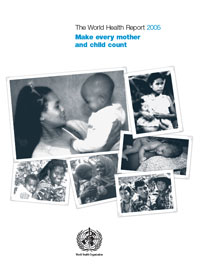 |
THE WORLD HEALTH REPORT 2005: MAKE EVERY MOTHER
AND CHILD COUNT
World Health Organization, 2005, 243 pages
|
С текстом доклада на английском языке можно ознакомиться
по адресу: http://www.who.int/whr/2005/whr2005_en.pdf,
а с кратким обзором доклада на русском языке по адресу http://www.who.int/whr/2005/overview_ru.pdf.
Дети - это будущее нашего общества, а их матери являются
хранителями этого будущего. Однако в 2005 году почти 11 миллионов
детей в возрасте до пяти лет умрут от причин, которые в значительной
степени поддаются предупреждению. Среди них 4 миллионов младенцев,
которые не выживут в течение первых месяцев жизни. В добавление
к этому, 3,3 миллиона младенцев родятся мертвыми. В то же время
около полумиллиона женщин умрут во время беременности, родов или
вскоре после этого.
В Докладе Всемирной организации здравоохранение о состоянии
здравоохранения в мире в 2005 году - "Не оставим без внимания
каждую мать, каждого ребенка" изучается, почему эти случаи
смерти продолжают происходить в таких масштабах и как уменьшить
ежегодное число этих жертв. Доклад содержит как экспертный анализ
препятствий для прогресса в области охраны здоровья матерей, новорожденных
и детей, так и полный набор рекомендаций, направленных на их преодоление.
В нем говорится, что сегодня уже существуют меры для изменения жизни
миллионов матерей и детей и предотвращения миллионов трагически
преждевременных случаев смерти.
Все страны должны гарантировать доступ к помощи для
каждой матери и каждого ребенка, обеспечив систему услуг, на протяжении
всего периода, начиная от беременности, родов, неонатального периода
и до детского возраста. В докладе подробно рассматривается, какие
усилия должны быть предприняты и какие понадобятся расходы для расширения
деятельности, направленной на обеспечение всеобщего доступа к этим
услугам в течение предстоящего десятилетия. Чтобы сделать это возможным,
необходимо увеличить инвестиции в системы здравоохранения и в людские
ресурсы для здравоохранения.
Здоровье матерей, новорожденных и детей должно занять
центральное место в обеспечении права на здоровье, защищаемого и
финансируемого из государственных средств и посредством систем медико-социального
страхования.
Доклад о состоянии здравоохранения в мире в 2005 году
имеет важное значение для всех тех, кто заинтересован в улучшении
здоровья каждой матери, каждого новорожденного и каждого ребенка.
CONTENTS
Message from the Director-General
Overview
Patchy progress and widening gaps - what went wrong?
Making the right technical and strategic choices
Moving towards universal coverage: access for all, with financial
protection
Chapter summaries
Chapter 1
Mothers and children matter - so does their health
The early years of maternal and child health
Where we are now: a moral and political imperative
Mothers, children and the Millennium Development Goals
Uneven gains in child health
The newborn deaths that went unnoticed
Few signs of improvement in maternal health
A patchwork of progress, stagnation and reversal
The numbers remain high
Chapter 2
Obstacles to progress: context or policy?
Context matters
Poverty undermines progress
The direct and indirect effects of HIV/AIDS
Conflicts and emergencies set systems back
The many faces of exclusion from care
Sources of exclusion
Patterns of exclusion
Different exclusion patterns, different challenges
Are districts the right strategy for moving towards universal
coverage?
A strategy without resources
Have districts failed the test?
Chapter 3
Great expectations: making pregnancy safer
Realizing the potential of antenatal care
Meeting expectations in pregnancy
Pregnancy - a time with its own dangers
Seizing the opportunities
Critical directions for the future
Not every pregnancy is welcome
Planning pregnancies before they even happen
Unsafe abortion: a major public health problem
Dealing with the complications of abortion
Valuing pregnancy: a matter of legal protection
Chapter 4
Attending to 136 million births, every year
Risking death to give life
Skilled professional care: at birth and afterwards
Successes and reversals: a matter of building health systems
Skilled care: rethinking the division of labour
Care that is close to women - and safe
A back-up in case of complications
Rolling out services simultaneously
Postpartum care is just as important
Chapter 5
Newborns: no longer going unnoticed
The greatest risks to life are in its beginning
Progress and some reversals
No longer falling between the cracks
Care during pregnancy
Professional care at birth
Caring for the baby at home
Ensuring continuity of care
Planning for universal access
Benchmarks for supply-side needs
Room for optimism, reasons for caution
Closing the human resource and infrastructure gap
Scenarios for scaling up
Costing the scale up
Chapter 6
Redesigning child care: survival, growth and development
Improving the chances of survival
The ambitions of the primary health care movement
The successes of vertical programmes
Time for a change of strategy
Combining a wider range of interventions
Dealing with children, not just with diseases
Organizing integrated child care
Households and health workers
Referring sick children
Bringing care closer to children
Rolling out child health interventions
The cost of scaling up coverage
From cost projections to scaling up
Chapter 7
Reconciling maternal, newborn and child health with health system
development
Repositioning MNCH
Different constituencies, different languages
Sustaining political momentum
Rehabilitating the workforce
Not just a question of numbers
Recovering from the legacy of past neglect
Destabilization with the best of intentions
Tackling the salary problem
Financial protection to ensure universal access
Replacing user fees by prepayment, pooling and a refinancing of
the sector
Making the most of transitory financial protection mechanisms
Generalizing financial protection
Channelling funds effectively
Statistical annex
Explanatory notes
Annex Table 1
Basic indicators for all WHO Member States
Annex Table 2a
Under-five mortality rates: estimates for 2003, annual average
percent change 1990-2003, and availability of data 1980-2003
Annex Table 2b
Under-five mortality rates (per 1000) directly obtained from surveys
and vital registration, by age and latest available period or
year
Annex Table 3
Annual number of deaths by cause for children under five years
of age in WHO regions, estimates for 2000-2003
Annex Table 4
Annual number of deaths by cause for neonates in WHO regions,
estimates for 2000-2003
Annex Table 5
Selected national health accounts indicators: measured levels
of expenditure on health, 1998-2002
Annex Table 6
Selected national health accounts indicators: measured levels
of
per capita expenditure on health, 1998-2002
Annex Table 7
Selected immunization indicators in all WHO Member States
Annex Table 8
Selected indicators related to reproductive, maternal and newborn
health
Index
|

